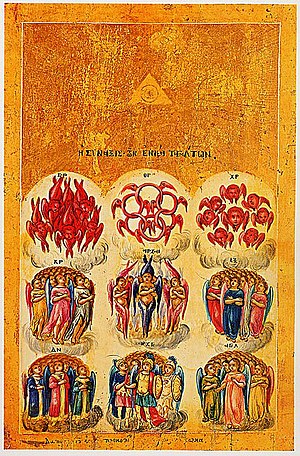Մասնակից:ԱրփիԱլեքս/Hierarchy of angels



Հրեշտակների աստիճանակարգություն, հավատ կամ ավանդություն, որն առկա է բազմաթիվ կրոնների հրեշտակաբանությունների հիերարխիայում: Այն ենթադրում է տարբեր մակարդակների և աստիճանների հրեշտակների գոյություն: Հնարավոր է պնդել, որ ավելի բարձր աստիճաններում գտնվողներն ունեն ավելի շատ զորություն կամ հեղինակություն ավելի ցածրում գտնվողների նկատմամբ, ինչպես նաև տարբեր աստիճաններում գտնվելով՝ նրանք տարբերվում են արտաքնապես, օրինակ ունեն թևերի կամ դեմքերի տարբեր քանակ:
Աբրահամյան կրոններ
[խմբագրել | խմբագրել կոդը]Հուդայականություն
[խմբագրել | խմբագրել կոդը]Հրեական հրեշտակների աստիճանակարգությունը ձևավորվել է Եբրայական Սուրբ Գրքի, Թալմուդի, Ռաբբունական գրականության և ավանդական Հրեական ծիսաբանության վրա: Տարբեր աստվածաբաններ առաջարկում են հրեշտակների տարբեր աստիճանակարգություն; ինչպես օրինակ, Մայմոնիդը իր ---- նշում է հրեշտակների տասը աստիճաններ:
They are categorized in different hierarchies proposed by various theologians. For example, Maimonides, in his Mishneh Torah or Yad ha-Chazakah: Yesodei ha-Torah, counts ten ranks of հրեշտակի angels.
Քրիստոնեություն
[խմբագրել | խմբագրել կոդը]Ամենամեծ The most influential Christian angelic hierarchy was that put forward by Pseudo-Dionysius the Areopagite in the 5th or 6th century in his book De Coelesti Hierarchia (On the Celestial Hierarchy). Dionysius described nine levels of spiritual beings which he grouped into three orders:[1][2]
- Highest order
- Middle order
- Lowest order
During the Middle Ages, various schemes were proposed, some drawing on and expanding on Pseudo-Dionysius, others suggesting completely different classifications.
Pseudo-Dionysius (On the Celestial Hierarchy) and Thomas Aquinas (Summa Theologiae) drew on passages from the New Testament, specifically Ephesians Ephesians 1:21 9 and Colossians 1:16, to develop a schema of three Hierarchies, Spheres or Triads of angels, with each Hierarchy containing three Orders or Choirs.
Islam
[խմբագրել | խմբագրել կոդը]There is no standard hierarchical organization in Islam that parallels the Christian division into different "choirs" or spheres, and the topic is not directly addressed in the Quran. However, it is clear that there is a set order or hierarchy that exists between angels, defined by the assigned jobs and various tasks to which angels are commanded by God. Some scholars suggest that Islamic angels can be grouped into fourteen categories, with some of the higher orders being considered archangels. Qazwini describes an angelic hierarchy in his Aja'ib al-makhluqat with Ruh on the head of all angels, surrounded by the four archangelic cherubim. Below them are the seven angels of the seven heavens.[3]
Zoroastrian
[խմբագրել | խմբագրել կոդը]There is also an informal Zoroastrian angelic hierarchy, with specific angelic beings called yazatas having key positions in the day-name dedications on the Zoroastrian calendar.
Role-playing games
[խմբագրել | խմբագրել կոդը]Angels are occasionally presented in role-playing games as having ordered hierarchies, within which higher level angels have more power and the ability to cast more spells or exercise other magical abilities. For example, Angels in Dungeons & Dragons, a subgroup of the beings called Celestials, come in three different types, the progressively more powerful Astral Deva, Planetar, and Solar.[4][5] Another game which has summonable angels is Shin Megami Tensei, often classified under Divine, or Heralds. In the game series Bayonetta angels are enemies and all 3 spheres are present, each divided in the same 3 orders as the tradition hierarcy.
See also
[խմբագրել | խմբագրել կոդը]References
[խմբագրել | խմբագրել կոդը]- ↑ Chase, Steven (2002). Angelic spirituality. էջ 264. ISBN 978-0-8091-3948-4.
- ↑ McInerny, Ralph M. (1998). Selected writings of Thomas Aquinas. էջ 841. ISBN 978-0-14-043632-7.
- ↑ Mehdi Amin Razavi Aminrazavi, Seyyed Hossein Nasr The Islamic Intellectual Tradition in Persia Routledge, 16.12.2013 9781136781124 p.17
- ↑ Jon Schindehette, Celestials, Angels, Devas: Dragon's-Eye View (January 9, 2013).
- ↑ Christopher Perkins, Warriors of Heaven (TSR, 1999).
